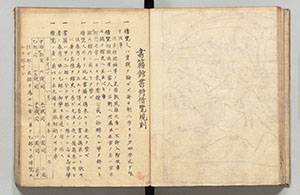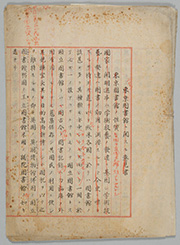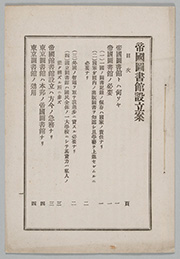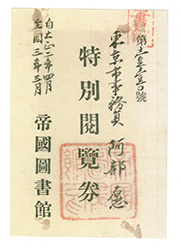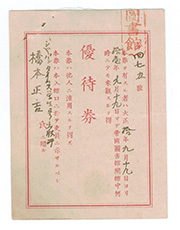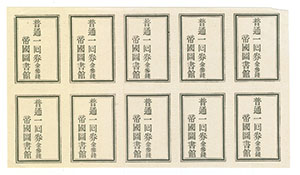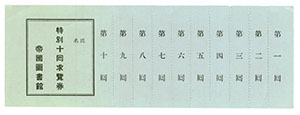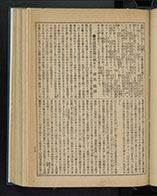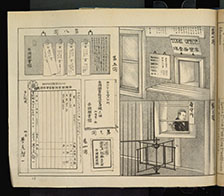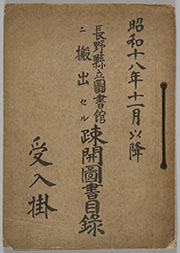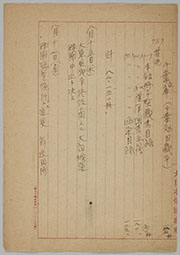70th Anniversary Commemorative Exhibit "A Treasure Box of Books - The 70-year History of the National Diet Library and Its Collections"
- A Treasure Box of Books
- Part 1 70 Years of the National Diet Library
- Section 1 National Diet Library Early History
Part 1 Section 1 National Diet Library Early History
The origins of the National Diet Library lay with the libraries of the pre-World War II House of Peers and House of Representatives and the Imperial Library. Of these, the Imperial Library in particular was constructed in 1897, continuing on from the establishment of its predecessor the Shojaku-kan (Library) in 1872 (which later became the Tokyo Shojaku-kan (Tokyo Library), Tokyo-fu Shojaku-kan (Tokyo-fu Library), and Tokyo Toshokan (Tokyo Library)), then having its name changed to the Kokuritsu Toshokan (National Library) in 1947, before being merged with the National Diet Library in 1949.
1 Imperial Library Nameplate
This nameplate is said to have been attached to the gatepost in 1929.
2 Shojaku-kan shosatsu shakuran kisoku Museum Division, Ministry of Education
Hakubutsukan zuga narabini Shojaku-kan shakuran kisokutou by the Museum et al. (early Meiji Era) [102-149]
The Shojaku-kan (Library), a pioneering institution for modern Japanese libraries which can also be said to be the origin of the National Diet Library, was opened in Yushima Temple on August 1, 1872. The Taiseiden (main hall of Confucius's Mausoleum), which was located in the center of the shrine, was used for the library stacks, while the corridors to the left and right were used as reading spaces. The displayed section is a copy of the reading room regulations distributed by the Museum Division, Ministry of Education in June before the library was opened.
3 Tokyo toshokan ni kansuru iken sho (A draft paper on the Tokyo Library written around 1891) Reproduction [帝文-41]
After returning to Japan in 1890, after approximately one and a half years of study in Europe and the United States, Tanaka Inagi, who would later become the first Director General of the Imperial Library, assumed a position as the Director of the Tokyo Library, and strove to build a national library that would rival those of other advanced nations. The exhibited material is a draft paper arguing Tanaka's position that a national library was necessary, which would later bear fruit in the form of exhibited material 4, Teikoku Toshokan setsuritsu-an.
4 Imperial Library setsuritsu-an Imperial Library (1896) [帝文-41]
At the 9th Imperial Diet in 1896, a proposal for the establishment of the Imperial Library was submitted to both the House of Peers and the House of Representatives, and was approved by both. The exhibited material is the setsuritsu-an (proposal for establishment) submitted at this diet session after long years of repeated refinement by Tanaka Inagi. The proposal explains that a "national library is like a university for all of the citizens".
5 Hanseiki mae no Tokyo (Tokyo a half-century ago)
Jijoden no kokoromi 24-27 by WATSUJI Tetsuro [WATSUJI Tetsuro] (1959) Reproduction [WB12-64]
Philosopher Watsuji Tetsuro graduated from the Himeji junior high school under the old system in 1906, then went to Tokyo approximately 10 days after the Imperial Library's annex was opened in Ueno. Watsuji named the "Ueno library" as one of his strongest impressions of Tokyo at the time, and recalls the high ceilings and chandeliers.
6 Toyoichi no toshokan (again)
Tokyo Asahi Shimbun No. 7038 Tokyo Asahi Shimbun Gaisha (March 19, 1906) [Z81-1]
The long-awaited opening of the Imperial Library was celebrated on March 20, 1906. The luxurious new construction in Ueno Park excited people, and various newspapers covered the opening ceremony and published details on the usage method for the library, as well as reporting on the expectations and hopes for the Imperial Library. The exhibited material introduces the building in lovely illustrations.
7 Imperial Library special reader's application form
8 Tokubetsu etsuranken (Special admission ticket for the Imperial Library)
9 Complimentary ticket
10 Ordinary single-use ticket
11 Special strip of 10 tickets
The exhibited materials are the various types of application forms for the Imperial Library. For the 3 years of the Shojaku-kan (Library), and from the 1885 era of the Tokyo Toshokan (Tokyo Library) until its rebirth as the UENO Library, Branch of the National Diet Library in 1949, fees were collected for use of the library.
- About the Imperial Library
-
The Imperial Library was frequently covered in magazines and other publications. These materials show a variety of historical library articles, such as the tickets and application forms used at the time, and mondoban (a board used for readers to ask each other questions and provide answers) which are no longer in use at the National Diet Library, as well as a newspaper reading stand, and other items, all illustrated by the artist Fukami Senrin. It's explained that the mondoban were installed as a means to carry out surveys, to clarify what books should be read, and for readers to ask and answer questions with other readers.
12 Nagano kenritsu toshokan ni hanshutsu seru sokai tosho mokuroku (Table of evacuated materials transferred to Nagano Prefectural Library), Ukeire kakari (November 1943-August 1944) Reproduction [帝文-788]
From 1943 to around the end of the war, there were worries of the library being damaged, so a large scale evacuation of some 300,000 materials was carried out to protect the important collection materials which were so painstakingly collected for the Library. The evacuation relocated the materials to the Nagano Prefectural Library (which were then transferred to Iiyama women's high school), private warehouses in Yamagata Prefecture, the basements of the Tokyo Imperial Household Museum, and other locations.
13 Daiyoji tosho chiho sokai ni kansuru oboegaki, Imperial Library (1945) Reproduction [帝文-787]
Immediately before the end of the war, the 4th evacuation was planned to move over 80,000 materials to the provinces. Those materials were planned to be transported on August 15, but the plan was cancelled because the war ended that day. However, the Imperial Library feared confiscation by the allied forces, and decided to continue the plan on the 17th, with transport to Akihabara Station completed on the 24th in order to evacuate the works to their final destination in Yamagata Prefecture.


